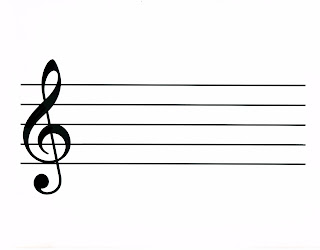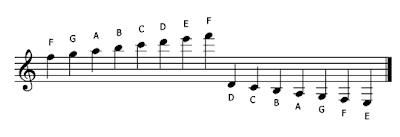Okay now that you've learned some notes on the 1st string, it's time to move over to the 2nd string. The notes you learned last time were E, F & G. In this lesson, we will learn B, C & D. The open 2nd string sounds the note "B". The note played at the 1st fret of the 2nd string is "C". And the note played at the 3rd fret of the 2nd string is "D". Just like the notes of the 1st string, we're only playing the open string, the 1st fret & the 2nd fret. Simple huh?
So let's try out these new notes on the 2nd string. Here's an exercise for you to practice:
It's basically the same exercise as the last one, only it's on the 2nd string instead of the 1st. Now try playing the notes on the 2nd string followed by the notes you learned on the 1st string & back again. Here's how it looks in notation:
So now you know B, C, D, E, F & G. They even sound like a scale when played one after the other, don't they? That's because they're all part of the C scale. In the next lesson, we'll put these notes together in a song & learn some notes on the 3rd string. But for now, let's learn some more chords!
So far, you've learned the open chords C, A, G, E & D. Every one of them is a major chord. But many songs aren't just made up of major chords - although some are. There are also minor chords. Minor chords are the sad, sombre chords you hear in music. So let's learn some of them!
This is the A minor chord - often written like this: "Am". Try playing the A Major chord followed by this one. Can you hear the melancholy flavor of A minor? A Major is a happy sounding chord by comparison. Weird isn't it? And all that from changing only 1 note. The note on the 2nd string is flatted by 1 fret, or by one half-step. More about steps & half-steps later. For now, strum the Am chord until it sounds smoothly & clearly. Note that the 6th string is not used, just like A Major.
The Am chord starts off some very popular tunes, just like all the other chords we've learned so far. It's the 1st chord of "Stairway To Heaven" by Led Zeppelin; and the first chord of "Glass Onion" & "Things We Said Today" by the Beatles; as is "Last Dance With Mary Jane" by Tom Petty. And thousands of others! A minor is a very popular key!
Here is the D minor chord. As with A minor, you're only moving one note from D Major to play D minor. I'll explain why it works this way in a later lesson. And notice that you only play four strings, just like D Major. So play D Major followed by D minor. Then try playing Am followed by Dm. D minor is a very sad key. Some say it's the saddest of all the keys.
Strum the D minor chord until you are proficient at it. D minor is also found at the start of many songs. "Sultans Of Swing" by Dire Straits, "Another Brick In The Wall (Part 2)" by Pink Floyd & "Paint It Black" by the Rolling Stones all start on D minor.
The last chord for this lesson is E minor. It's one of the simplest chords to play, since it only uses 2 fingers. And you play all 6 strings. Some songs that start on E minor: "Welcome To The Machine"by Pink Floyd; "Turn The Page" by Bob Seger & "Riders On The Storm" by the Doors.
Try playing G, then Em, then C, then D. That's the chord progression for "Stand By Me" by Ben E. King. And it's the same progression used in "Blue Moon" by the Platters. In fact, it's commonly referred to as the "50's progression" because so many artists from that era either used it outright, or used some variation of it.
Anyway, congratulations on learning your first minor chords. You now know enough chords to play for hours on end. Keep practicing & trying different combinations. Next lesson, I'll give you some chord progressions you can really sink your teeth into. Rock on!



























